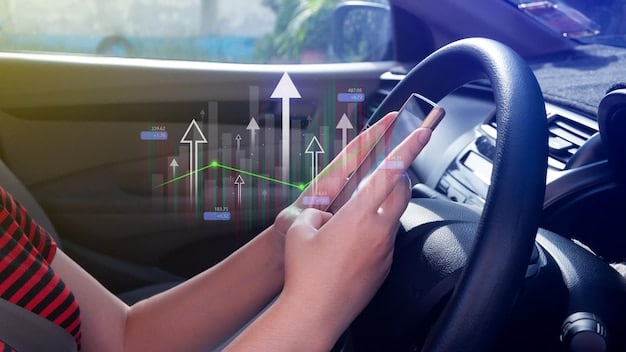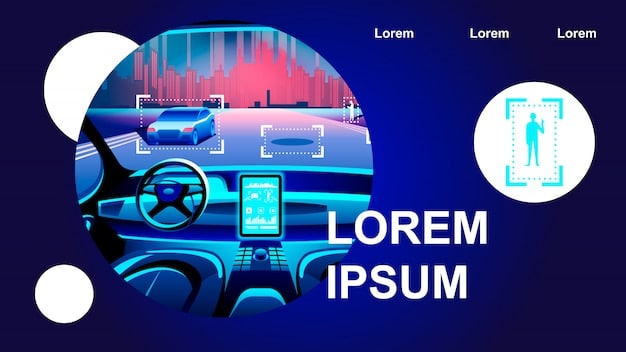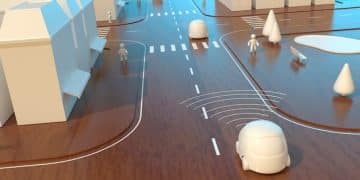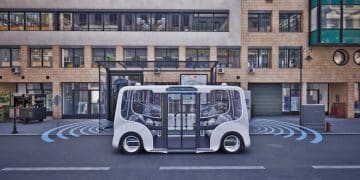Augmented Reality Dashboards: The Future of Driver Information?

Augmented Reality (AR) dashboards are poised to revolutionize driver information systems by projecting crucial data directly onto the windshield, promising enhanced safety and a more intuitive driving experience.
Are Augmented Reality (AR) Dashboards: Are They the Future of Driver Information Systems? Imagine a world where vital driving information—speed, navigation, warnings—is seamlessly projected onto your windshield, enhancing safety and convenience. This is the promise of augmented reality (AR) dashboards, a technology poised to revolutionize how we interact with our vehicles.
What are Augmented Reality (AR) Dashboards?
Augmented reality (AR) dashboards blend the real world with computer-generated information, providing drivers with a more intuitive and safer driving experience. This technology overlays digital data onto the windshield, allowing drivers to see essential information without taking their eyes off the road.
How AR Dashboards Work
AR dashboards utilize sensors, cameras, and projection systems to gather real-time data about the vehicle’s surroundings. This information is then processed and displayed on the windshield, creating an augmented reality experience. Critical data such as speed, navigation prompts, lane departure warnings, and traffic alerts are projected directly into the driver’s field of view.
Components of an AR Dashboard
An AR dashboard typically consists of several key components working in harmony to deliver a seamless and informative experience. These components include sensors, cameras, processing units, and projection systems. Together, they capture, analyze, and display real-time data in a user-friendly manner.
- Sensors: These devices collect data about the vehicle’s speed, location, and surroundings.
- Cameras: Cameras capture images of the road ahead, identifying lane markings, traffic signs, and other vehicles.
- Processing Units: These units analyze sensor and camera data to generate augmented reality displays.
- Projection Systems: Projectors display the augmented reality information onto the windshield.
In essence, AR dashboards aim to provide a safer and more intuitive way for drivers to access crucial information while minimizing distractions. By keeping the driver’s focus on the road, AR technology can significantly improve overall driving safety and awareness.

Benefits of Augmented Reality in Driver Information
The integration of augmented reality into driver information systems offers numerous benefits, enhancing safety, convenience, and overall driving experience. By overlaying pertinent data onto the driver’s field of vision, AR technology aims to create a more intuitive and responsive driving environment.
Enhanced Safety
One of the most significant advantages of AR dashboards is the improvement in driving safety. By projecting crucial information such as speed limits, navigation cues, and hazard warnings directly onto the windshield, drivers can react more quickly and effectively to potential dangers without diverting their gaze from the road.
Improved Navigation
AR-enhanced navigation systems offer real-time guidance overlaid on the driver’s view of the road. This intuitive approach helps drivers follow directions more easily and accurately, reducing the likelihood of missed turns and navigational errors, especially in complex urban environments.
Reduced Driver Distraction
Traditional dashboards can sometimes be distracting, requiring the driver to look down and away from the road to access vital information. AR dashboards mitigate this issue by placing necessary data directly within the driver’s line of sight, thereby minimizing distractions and promoting safer driving habits.
- Real-Time Alerts: Provide immediate warnings about potential hazards, such as pedestrians or sudden lane changes.
- Adaptive Cruise Control: Integrates with AR to display information about the distance to the vehicle ahead.
- Lane Keep Assistance: Visually guides the driver to stay within the lane markings, reducing the risk of unintentional drifting.
In conclusion, augmented reality offers compelling benefits for driver information systems, with enhanced safety, improved navigation, and reduced distraction as prominent advantages. As the technology continues to evolve, AR dashboards are poised to become an integral component of modern vehicles, contributing to a safer and more enjoyable driving experience.
Challenges and Limitations
While augmented reality (AR) dashboards offer numerous potential benefits, they also present several challenges and limitations that need to be addressed before widespread adoption can occur. These challenges range from technological hurdles to user acceptance and regulatory considerations.
Technological Challenges
Developing reliable and accurate AR systems for automotive applications requires overcoming several technological hurdles. Ensuring the accurate projection of information onto the windshield, accounting for varying lighting conditions, and minimizing latency are key challenges that engineers must address.
Cost Considerations
The cost of integrating AR technology into vehicles can be a significant barrier to entry, particularly for mass-market vehicles. High-resolution displays, advanced sensors, and powerful processing units all contribute to the overall cost, which can make AR dashboards a more expensive option compared to traditional systems.
User Acceptance
For AR dashboards to gain widespread acceptance, drivers need to feel comfortable and confident in using the technology. Issues such as information overload, visual clutter, and potential distractions need to be carefully managed to ensure that AR enhances rather than detracts from the driving experience.
- Display Clarity: Ensuring that AR projections are clear and legible in all lighting conditions is essential.
- Information Overload: Avoiding overwhelming drivers with too much information is crucial for maintaining focus.
- Sensor Accuracy: The accuracy of sensors and cameras is vital for providing reliable AR assistance.
Future Trends in AR Dashboards
The future of AR dashboards is bright, with ongoing innovations promising to enhance their capabilities, usability, and integration into everyday driving experiences. These trends include advancements in display technology, sensor fusion, and artificial intelligence (AI).

Advancements in Display Technology
Next-generation AR dashboards are likely to feature advanced display technologies that offer improved brightness, contrast, and resolution. Holographic displays and laser projection systems could enable more immersive and visually appealing augmented reality experiences.
Integration of AI and Machine Learning
AI and machine learning algorithms can play a key role in enhancing the functionality of AR dashboards. These technologies can analyze vast amounts of data to provide personalized recommendations, predict potential hazards, and adapt the AR display to the driver’s preferences and driving style.
Sensor Fusion and Data Integration
Combining data from multiple sensors, including cameras, radar, and lidar, can provide a more comprehensive understanding of the vehicle’s surroundings. This sensor fusion approach can enable AR dashboards to deliver more accurate and reliable information to the driver.
- Gesture Control: Incorporating gesture recognition could allow drivers to interact with AR displays without touching physical controls.
- Personalized Information: AR dashboards could customize the displayed information based on the driver’s preferences and habits.
- Predictive Assistance: AI-powered AR systems could anticipate potential hazards and provide proactive warnings to the driver.
In summary, the future of AR dashboards is characterized by ongoing advancements in display technology, AI integration, and sensor fusion. These trends promise to make AR dashboards more sophisticated, intuitive, and beneficial for drivers, paving the way for widespread adoption in the automotive industry.
Testing and Evaluation
Rigorous testing and evaluation are crucial for ensuring the safety, reliability, and usability of augmented reality (AR) dashboards. These processes involve laboratory testing, on-road evaluations, and user feedback, all aimed at refining and optimizing the technology.
Laboratory Testing
Laboratory testing involves evaluating the performance of AR dashboards under controlled conditions. This includes assessing display clarity, projection accuracy, and system latency using specialized equipment and measurement techniques. Simulations of various driving scenarios and environmental conditions are also conducted to identify potential issues.
On-Road Evaluations
On-road evaluations assess the performance of AR dashboards in real-world driving conditions. These evaluations involve experienced test drivers who evaluate the system’s ability to provide timely and accurate information, reduce driver distraction, and enhance overall safety. Data is collected on driver behavior, eye movements, and reaction times to assess the impact of AR on driving performance.
User Feedback and Surveys
Gathering feedback from a diverse group of drivers is essential for understanding user perceptions and identifying areas for improvement. Surveys, focus groups, and user interviews are used to collect data on user comfort, usability, and overall satisfaction with AR dashboards. This feedback is then used to refine the design and functionality of the system.
- Eye-Tracking Analysis: Monitors driver’s eye movements to assess how effectively they are processing AR information.
- Cognitive Load Measurement: Measures the mental effort required to use AR dashboards under various conditions.
- Crash Simulation: Evaluates how AR can assist drivers in avoiding accidents and mitigating the severity of crashes.
In the end, by combining laboratory testing, on-road evaluations, and user feedback, developers can ensure that AR dashboards are safe, reliable, and beneficial for drivers. These rigorous testing processes are essential for building trust in the technology and paving the way for its widespread adoption in the automotive industry.
Impact on the Automotive Industry
The integration of augmented reality (AR) dashboards is poised to have a significant impact on the automotive industry, transforming how vehicles are designed, manufactured, and experienced. This technological shift promises to enhance safety, improve the driving experience, and introduce new business opportunities for automakers and technology providers.
Changing Design Paradigms
AR dashboards challenge traditional design paradigms by allowing automakers to declutter physical dashboards and prioritize digital information displays. This shift enables designers to create more minimalist and user-friendly interiors, focusing on essential controls and intuitive interfaces.
Creating New Revenue Streams
AR technology opens up new revenue streams for automakers by enabling subscription-based services, personalized content, and targeted advertising. Drivers can subscribe to premium AR features, such as enhanced navigation, real-time traffic updates, and integrated entertainment offerings, creating recurring revenue opportunities.
Enhancing User Experience
AR dashboards enhance the overall user experience by providing drivers with a more immersive and informative driving environment. By overlaying relevant data onto the windshield, AR technology can reduce driver distraction, improve situational awareness, and make driving safer and more enjoyable.
- Automated Driving Systems: AR can enhance automated driving systems by providing visual feedback and transparent information about the vehicle’s decisions.
- Customizable Interfaces: AR dashboards allow drivers to customize the interface to display the most relevant information according to their preferences.
- Predictive Maintenance: AR can provide drivers with real-time information about vehicle health and maintenance needs.
In conclusion, the impact of AR dashboards on the automotive industry is multifaceted, encompassing design innovation, new revenue opportunities, and enhanced user experiences. As the technology matures, it is expected to play an increasingly important role in shaping the future of mobility and transforming how we interact with our vehicles.
| Key Point | Brief Description |
|---|---|
| 🚗 Enhanced Safety | Projects crucial info on windshield, reducing distractions. |
| 🗺️ Improved Navigation | Real-time guidance overlaid on the driver’s view. |
| 💡 Future Trends | Advancements in displays, AI integration, and sensor fusion. |
| 💰 New Revenue | Opens new streams through subscriptions and personalized content. |
Frequently Asked Questions
▼
An AR dashboard uses augmented reality to project digital information onto the windshield, allowing drivers to see vital data without taking their eyes off the road. This improves safety and offers a more intuitive driving experience.
▼
By displaying speed limits, navigation cues, and hazard warnings directly in the driver’s line of sight, AR dashboards reduce the need to look away from the road, minimizing distractions and improving reaction times to potential dangers.
▼
Challenges include overcoming technological hurdles such as projection accuracy and varying lighting conditions, managing costs, and ensuring user acceptance by avoiding information overload and visual distractions during the AR experience.
▼
Future trends include advancements in display tech like holographic projections, AI integration for personalized experiences, and combining data from multiple sensors to improve accuracy and reliability of the AR insights displayed to the driver.
▼
Automakers can generate new revenue streams by offering subscription-based services for premium AR features, providing personalized content, offering targeted advertising, and providing automated driving system improvements based on data collection.
Conclusion
In conclusion, augmented reality (AR) dashboards present a transformative shift in automotive technology, promising enhanced safety, improved user experiences, and new revenue opportunities for automakers. While challenges remain in terms of technology, cost, and user acceptance, ongoing innovations are paving the way for widespread adoption, positioning AR dashboards as a key element in the future of driver information systems.




